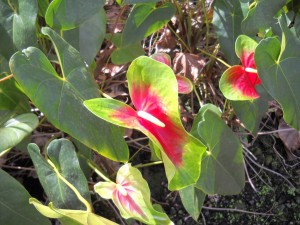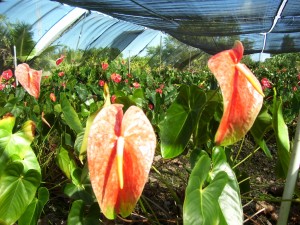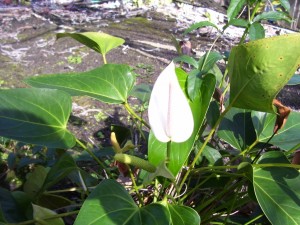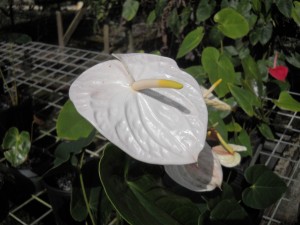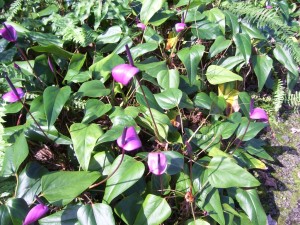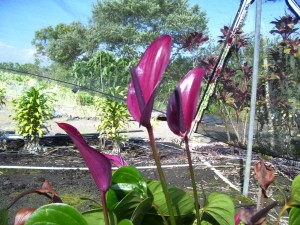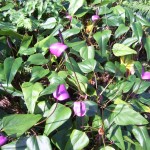How To Plant An Anthurium In A Pot
This is another article in my series of articles on anthurium care. In this article, I will discuss how to plant an anthurium in a pot. If you want to pot an anthurium, there are several things that you need to keep in mind.
First you need to consider the size of the plant that you wish to pot. Is it coming from tissue culture or a top cutting? In general, tissue culture plants are tiny, so you can use a small two inch pot. But if you are taking a top cutting, you could be dealing with a medium to a large plant. So you may need a pot that is anywhere from four inches to twelve inches in size.
Second, you need to use the proper growing media. The most important factor when choosing a growing media is that it drains well. Excess water can allow anaerobic bacteria or fungus to grow. These organisms can kill your plant, so you have to make sure that the growing media does not hold excess water. Anything that adds porosity to your media works. You can use perlite, sand, gravel, wood chips, volcanic cinder or pumice.
Third, now that you have settled on a pot and the growing media, you will need to pot your plant. Take a scoop of growing media and put it on the bottom of the pot. Next, put your plant into the pot and put additional media into the pot, around your plant. Stop once you have filled the pot almost to the brim. Add a small dose of slow release fertilizer and that should do it.
Now that you have finished potting your plant, give it a thorough watering to allow the soil to settle and to hydrate your anthurium. Next, find a bright spot that is out of direct sunlight to put your newly potted anthurium. Finally, make sure that your plant doesn’t get to hot or cold: it is especially vulnerable after being potted. And make sure that you water it regularly.
Hawaii: A Few Of Hawaii’s Natural Wonders
The State of Hawaii is filled with amazing natural beauty. It has extraordinary flowers like: hibsicus, ginger and anthuriums. It has rare creatures like the Hawaiian Hawk and the Hawaiian Bat. And it has incredible natural wonders like valleys, mountains and waterfalls.
Volcano is a small village on the Island of Hawaii, where the Kilauea Volcano is located. If you pay a small fee, you can visit the Volcano National Park. The park has a number of magnificent attractions including Halemaumau Crater, the Jagger Volcano Observatory and the Thurston Lava Tube. Where else can you walk across the bottom of a volcanic crater, see steam pouring out of the earth and cruise through a lava tube? You can also have lunch at the Volcano House Restaurant, which over looks a gigantic crater.
Mauna Kea is a mountain on the Big Island that is home to many of the best observatories in the world. Situated in the middle of the Pacific it has some of the cleanest air in the world and is an excellent location for peering into the outer reaches of the universe. Measured from its base, at the sea floor, it is taller than Everest. Mauna Kea is frequently covered with snow, a rare sight in on a tropical island. From its summit you can see the whole island.
In the Iao Valley of Maui, you will find the Iao Needle. It is a massive 2,000 foot tall stone column that is covered with vegetation. Way back in 1790, the valley was the sight of an important battle that led to the unification of the Hawaiian Islands. This monument in the verdant Iao Valley was once used by the ancients an altar.
Right outside the quaint village of Honomu, you’ll find Akaka Falls Park. It is home to a towering, 400 foot waterfall called Akaka Falls. When you enter the park, you will be awed by the majestic beauty of the tropical jungle that surrounds the falls. You will hear many native birds singing and you will see quite a number of native trees. When you reach the end of the short trail to the falls, you will be overwhelmed by the roar of thousands of gallons of water rushing over the falls.
Obake Anthurium: How To Fertilize An Obake Anthurium
Obake Athuriums produce some of the biggest and most beautiful anthurium flowers. Their flowers are much bigger and wider than regular anthuriums and they are also much more colorful. Usually they will produce flowers that have two or more colors. If you have a prized obake anthurium and you want it to produce the biggest and best flowers that it is capable of producing, this is what you need to do.
Sure, you could take the easy way out and utilize slow release fertilizer, and just apply it twice per year and be done with it. This is simple and easy to do. But this will not enable your plant to live up to its full potential. Doing this will keep it healthy and allow it to produce reasonable flowers.
If you want your plant to produce the best flowers that it is capable of producing, you need to use an approach that takes a lot more work. But if you have a highly prized plant the extra work will be worth it, when you see your plant growing well and producing amazing flowers.
What you need to do is feed it with liquid fertilizer. You will need to dilute the liquid fertilizer to roughly ten percent of the strength recommended on the label and you will need to apply it every week on a consistent basis. Make sure a little fertilizer gets poured on your plant’s leaves and stalk, in addition to its roots, because your plant can absorb nutrition through these areas too.
Watch out if the leaves on your obake anthurium plant turn yellow or brown, as this is a sign that it is getting too much fertilizer. If this happens, flush out the fertilizer with a dose of water and reduce the amount of fertilizer that you are applying. If you follow this routine consistently, your plant will grow faster and produce bigger and better flowers.
Obake Anthurium: How To Breed New Obake Anthurium Flowers
I think obake anthurium flowers are the most beautiful variety of anthurium flowers. They come in an incredible variety of colors and usually each flower has a mix of colors rather than being a single solid color. Furthermore, they are much bigger and showier than regular anthuriums. Today, I would like to give you a brief overview of how to breed them. Selective breeding is what growers use to create new and even more impressive varieties of obake anthuriums.
Everything starts with selecting two plants that have interesting characteristics. There are a number of characteristics that a grower may be looking at, size, shape, color and color patterns are all important factors. Generally, if you want to produce a new obake, both parent plants should have the obake characteristics of multiple colors and an elongated spathe. But, sometimes you can’t find an obake with the desired color, so you may choose to have only one obake parent plant.
Once the parent plants are chosen, you have to wait until one of the plants grows a flower and produces pollen. You will then have to gather the pollen. This is done by using a small brush to brush pollen off the stamen into a small jar. If the other parent plant has a receptive flower, you can then dust the pollen onto its stigma. But if the other plant doesn’t have a receptive flower you will have to freeze the pollen until it is ready for use.
Finally, you have to wait until seeds form. This can take a really long time, up to a year or more. Once the seeds have matured, they are planted. And even more waiting is required. You can end up waiting up to two to three years for the new plants to produce flowers. Then and only then will you be able to see if your efforts to produce a new and interesting obake anthurium were successful. If you find an obake anthurium flower that you like, you can take it to a lab and have it tissue cultured and create millions of copies of it.
Anthurium Fertilizing Frequency
A common question that comes up when discussing anthurium care is: how often should you fertilize your anthurium flowers? The correct answer is that it depends. It depends on the type of soil that you are growing your anthuriums in, the location where you are growing your plant and the type of fertilizer that you are using.
Anthuriums come from the jungles of South America. In their jungle home no one goes around fertilizing them. They obtain all the nutrients that they need from nature and so do not require any artificial fertilizer. So if you are growing them outside, under a shade tree that drops a fair amount of leaves, you probably don’t need to fertilize them at all, as long as you allow the leaves from the tree to decompose around your plants.
If you are growing your plants in pots, whether in doors or outdoors, they will require fertilizer. But the frequency that you fertilize depends on the type of fertilizer that you use.
Slow release fertilizer has a special coating that does exactly what its name implies. It releases nutrients slowly, over a period of time. Each time you water your plant, a little bit of the coating dissolves and this allows nutrients to escape and reach the roots of your plant. It is best to apply slow release fertilizer twice a year.
With liquid fertilizer, the nutrients are released to your plant immediately, so you have to apply it much more often. In general, you should apply it once per week, when you are watering your plant. But you have to make sure that it is diluted to roughly 10% of the strength indicated on the label. Anthuriums don’t need a lot of nutrients and high doses of fertilizer can harm them. It is always better to apply too little fertilizer rather than too much.
How To Grow Anthuriums Outdoors
To start, not everyone can grow anthuriums outdoors. In some parts of the world, due to climate conditions, anthuriums can only be grown indoors. But if you are one of the lucky people to live in a place where the temperature does not drop below sixty degrees, there is a good chance that you will be able to grow anthuriums outdoors.
First, you need to confirm that the region where you live has suitable weather conditions. The temperature must stay between 60 degrees and 90 degrees. These plants may survive for a short while outside of this range, but in general they will be harmed if temperatures go beyond this range. Wind is also a factor. If you live in an area that is windy, the wind may harm your plants. If the leaves on other plants with broad leaves in your area are fine, this means that the wind should not be a concern.
Second, you will need a place that has bright indirect sunlight. These plants can’t handle direct sunlight, but they can’t grow in the dark, either. The ideal location is in a sunny area under a tree that blocks out a portion of the light.
Third, you will need a soil that drains well. These plants do well in just about any soil that has a reasonable amount of organic matter, but the common attribute of any growing medium is that it has to drain well. If it doesn’t, these plants will eventually die of root rot or fungus.
Once you have found or created a place in your garden that meets all of these conditions, all you need to do is take your anthuriums out of their pots and plant them. If you are planting them under a tree, a good way to arrange them is in a circle or semi-circle around the trunk, with roughly a foot between each plant. Finally, make sure that they receive water regularly and they should grow well and produce many beautiful flowers.
Anthurium Care: How To Fertilize An Anthurium
Taking care of an anthurium is easy once you have learned the basics of anthurium care. In previous articles, I have covered where to keep your anthurium and how to water it. In this article I will discuss how to fertilize an anthurium.
Improper fertilization of your plant can kill it, so it is important to learn how to fertilize it correctly. The most important thing to keep in mind is to never over fertilize your plant. If you are uncertain as to how much fertilizer you should give your plant, make sure you give it less than you think it needs. If you over fertilize your plant you can kill it. While, if you under fertilize your plant, the worse that will happen is that it will grow a little slower.
There are two types of fertilizer that can be used to fertilize an anthurium: slow release or liquid. With slow release, you apply it once and don’t have to apply it again for six months. With liquid fertilizer, you will have to apply it every week. In general, I recommend using slow release fertilizer unless you are willing to devote a lot of attention to your plant.
The main thing to look for in a fertilizer is an even ratio of nitrogen, phosphorus and potassium. To find this type of fertilizer, just look at the numbers on the bottle. They should be something like 15-30-15.
Once you have selected a fertilizer, you will need to apply it. To apply it just read the directions on the label and reduce the amounts you see there by 75%. Let’s say that the label says that for 8 inch pots you should apply 1 teaspoon, for an anthurium in an 8 inch pot you should instead apply a quarter teaspoon. As far as application frequency, a slow release fertilizer should be applied once every six months.
Anthurium Species And Cultivars
There are many different anthurium species and cultivars. Many more are being discovered or created each year. This is my guide to the various species and cultivars.
Anthurium Andraeanum Cultivars
Waimea Anthurium
The Waimea is a red anthurium that was created to fill an important need. Red anthuriums are very popular flowers, but the foremost variety of red anthurium, the Ozaki, was decimated by a bacterial blight. The Waimea was created in response to this. It is a blight resistant variety that produces a lot of bright red flowers.
The Waimea was created back in 1987 by crossing Paradise Pink with a Marian Seefurth hydrid. The result was a fast growing plant that produced six flowers a year on average. The Waimea anthurium produces medium sized, heart shaped flowers with a red spathe and a spadix that changes from orange-red to red-purple. The flowers that it produces have a vase life of approximately 28 days.
Centennial Anthurium
The Centennial is a white anthurium that was named for the 100 year anniversary of higher education in the Hawaiian Islands. The Centennial has a lot of symbolic meaning for the University of Hawaii. It produces a white flower with green veins. White and green are the colors of the university. The veins merge together that the base of the flower and this represents the many diverse cultures that have come together at the university.
A lot of work went into the breeding of the Centennial. It is a hybrid that was made from four different species of anthurium: A. andraeanum, A. lindenianum, A. amnicola, and A. antioquiense. It produces a white tulip shaped flower with mild obake tendencies. It has a yellow-green spadix that turns white. As a plant it produces dark green leaves and many offshoots. It is great as a cut flower and as a potted plant.
New Era
The New Era is a purplish-pink anthurium that received its name by being the first blight resistant anthurium. It is ushering in a new era of blight tolerant anthuriums. It has a slightly elongated spathe and a yellow-green spadix that turns white as it matures.
The New Era was a result of crossing three different cultivars. An A494 Anthurium andraeanum was crossed with an A. antioquiense, and the result of this pairing was again crossed with a pink UH507 to produce this lovely flower. It has a long stem and is resistant to both bacterial blight and anthracnose. It was released to cooperating growers back in 2004 and it produces approximately 6 flowers per year. It also has an excellent vase life of 44 days.
Le’ahi
The Le’ahi is a pink and green obake that is named after the Hawaiian name for Diamond Head, the iconic volcanic cone that is a prominent Oahu landmark. The Le’ahi’s keeps its beautiful coloration year-round and produces almost 8 flowers a year. Unfortunately, it is susceptible to blight, so it is a slightly harder variety to grow.
The Le’ahi was created by mixing a child of orange-colored UH931 and a pink-colored Blushing Bride. It is a variety that works well as a potted plant and as a cut flower. Though as a cut flower, some say it has a stem that is a little too short. But its unusually beautiful color pattern, helps to offset its short stems.
Tropic Sunrise
The Tropic Sunrise is a large orange obake flower that was created back in 1981 by crossing an Anuenue with an Soga Orange. It produces a large flower that is orange in the middle and green at the edges that can grow up to one foot long. It has a yellow spadix that turns white as it matures.
The coloration and size of the Tropic Sunrise are its best attributes. It produces its flowers on strong stems that can be up to 30 inches long. Its flowers can last up to 27 days in a vase and the plant produces roughly 6 flowers per year. Testing has shown that it is a strong plant with a slight susceptibility to anthracnose.
White Lady
The White Lady is another amnicola based hybrid. It produces small white tulip shaped flowers that have a tendency to be a little longer than other tulip shaped species. It was created by crossing four different species, so it has quite a mixed heritage. It has small dark green leaves that are shaped like elongated spades. And it makes an excellent potted plant or cut flower.
As a cut flower, White Lady, has a vase life of 25 days. As its flowers age they can develop a pinkish hue, so they look great on potted plants. It is a great plant for growers and hobbyists because it is highly resistant to both anthracnose and blight. It yields approximately 6 flowers a year. The spadix on these flowers can grow to six inches long and their stems grow up to 22 inches. The spadix starts out yellow and changes to green as the flowers mature.
Hokuloa
The Hokuloa is a beautiful white anthurium. In Hawaiian, the word Hokuloa refers to the planet Venus, which is otherwise known as the morning star. It is a brilliant white flower that is worthy of its name. It comes in the standard heart shaped configuration and has a yellow spadix that changes to white as the flower matures. It produces medium five inch wide flowers on stems that are up to 27 inches. It is a hardy plant that is resistant to both blight and anthracnose, so it is relatively easy to grow.
The Hokuloa was created by breeding a Tropic Mist, which produces large cream colored flowers with selection 768-47, which is a hybrid of a Marian Seefurth and an A. antioquiense. This created a plant with glossy white flowers that are resistant to rain damage. It grows well in tissue culture and produces roughly 6 flowers per year. It has an excellent 37 day vase life, so it makes a great cut flower.
Hilo Moon
The Hilo Moon is another white anthurium with a celestial name. It is closely related to the Hokula and is in fact a sibling of it as they share the same parents. Sometimes, when you cross two plants, you get several child plants that are worth cultivating. Like actual siblings, you can see the resemblance, but they have their own unique qualities.
The Hilo Moon looks almost like the Hokuloa, except it is slightly less symmetrical. It is the same white color and it has the same yellow spadix that changes to white as the flower matures. It has a higher yield and can produce up to 8 flowers per year, but unfortunately its flowers have a shorter vase life, only 22 days, compared to 37 days. It shares a resistance to blight and anthracnose and it produces more offshoots than its sibling.
Anthurium Species
There are more than eight hundred species of anthurium plants in the world. But what is even more remarkable is that more species are being discovered each year. So the ultimate number of anthurium species may be much higher than eight hundred. Of these eight hundred species of anthurium, only four species are sold commercially. And these four species can be lumped into two categories: foliage or flowers.
Foliage Species
The two species grown for foliage are: Anthurium Crystallinum and Anthurium Faustinomirandae. A. Crystallinum normally produces large two foot long leaves. Its leaves have a smooth surface and dark green color that is punctuated by pale, white veins. While, A. Faustinomirandae has even larger green leaves that are very thick and sturdy. Its leaves can be up to five feet long.
Anthurium Scherzerianum
The first species grown for their flowers is Anthurium Scherzerianum. A. Scherzerianum is a plant that is very difficult to kill and hence it is a great choice for a novice anthurium grower. It produces a large number of flowers, but its flowers are not as impressive as the flowers produced by A. Andreanum. Usually its flowers are small, white and have a curly orange nose.
Anthurium Andraeanum
And the second species grown for flowers is Anthurium Andraeanum. Almost all of the flowers that you will see in a flower shop will be members of this species. Back in the 1940’s, Hawaii’s anthurium growers discovered that they could breed anthuriums selectively. This led to explosive growth in the number of varieties of anthurium flowers.
Anthurium Watermaliense
Anthurium Watermaliense gets its name from the town of Watermall, which is in Belgium. Watermall was the town where this plant was first taken after being collected in Columbia. It is also known as the “black anthurium”, though it really isn’t black. It produces flowers that are dark purple, which I suppose can be mistaken for black in the dim light of a jungle. The distinguishing characteristic of this species is a stipe, which other anthuriums do not possess. A stipe is a piece of stem that offsets the spadix from the spathe on these flowers. On other anthuriums, the spadix emerges directly from the spathe.
Anthurium Plowmanii
Anthurium Plowmanii is named after botanist Timothy Plowman, who has discovered and catalog a large number of plants from the Amazon. It grows in various parts of South America at elevations ranging from sea level to 3000 feet and it tolerates dry conditions much better than many other members of the anthurium family. It is sometimes called Anthurium Plowmanii Ruffles or Anthurium Fruffles, possibly because of the wavy shape of its leaves. It can grow to a decent size and grows in what is sometimes called bird’s nest form; if you use your imagination it kind of looks like a bird’s nest for perhaps a pterodactyl.
Anthurium Magnificum
Anthurium Magnificum is aptly named, it produces large and magnificent leaves. It’s olive green leaves with silver veins can grow up to two feet long and the surface of its leaves has a velvety texture. The main way to identify this species is to look at the petiole; members of this species possess square shaped petioles. In the wild, this species is only found in Columbia, but it is capable of growing in many other parts of the world. And many people grow it because of the beautiful leaves that it produces. It makes a great ornamental plant.
From their humble beginnings in Central and South American rain forests, anthurium plants have come a long way to Hawaii, and they haven’t stopped there. Now they are cultivated commercially in: Holland, Mauritius, Costa Rica and many other parts of the world. And they have a bright future as growers are continuing to breed incredible new varieties.
Anthurium Amnicola aka Tulip Anthuriums
Tulip anthuriums originally hail from the tropical South American country of Panama. In the wild, they like to grow on boulders that are located next to streams. I guess they like hanging out by rivers, just like fly fishermen do.
They are a most excellent variety of anthurium, because they have a pleasant, swell-smelling fragrance and they can produce up to eight flowers a year. Furthermore, they make excellent indoor plants, because they are small and don’t take up a lot of room.
They are an interesting kind of anthurium because of the distinctive shape of their flowers. Instead of being heart shaped like most other anthuriums, they are tulip shaped. They have light purple petals and dark purple noses. I like how they are like tulips with a tropical ambiance. Pure-breed Amnicola produce small, dark-green, spade shaped leaves and small flowers with short stems that generally top out at twelve inches long.
Amnicola has frequently been hybridized with Anthurium Andraeanum to produce a variety of flower colors, which include: purple, red, pink, purple, green, fuschia, lavender and white. Pure-breed amnicola and hybrid amnicola can both produce up to eight flowers a year, so your amnicola could have flowers on it year round. It also produces offshoots quite readily, so it is ideal if you want to produce more plants. You can let the offshoots develop for a while and once they are big enough you can separate them from the parent plant and put them into their own pots.
Some of the hybrids can have interesting names such as Misty Pink, Lady Jane, Pink Elf, and Pink Champagne. Others have less creative names like: Andraecola-1 and Andraecola-2 that were created by taking the first part of Andraeanum and the last part of Amnicola and putting them together. Of course these will probably be given other names at some point.



